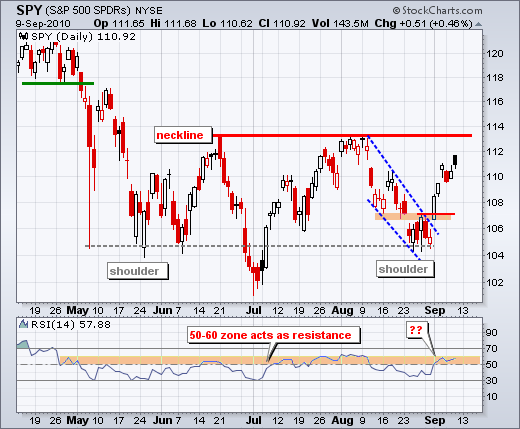There is no real change on the daily chart as SPY labors higher. The ETF fell back with a red candlestick on Tuesday, edged higher with a small white candlestick on Wednesday and then formed a filled black candlestick yesterday. Black means the close was up from the prior close. Filled means the close was below the open. The ETF has not done much since opening at 110.54 last Friday. Overall, SPY remains in a trading range with support around 104 and resistance around 113. The ETF is much closer to resistance than support. In addition, SPY is up around 5% the last six days, which makes it short-term oversold and still ripe for a pullback or further consolidation. RSI is trading in a resistance zone around 50-60. This area has marked momentum resistance since late April.


On the 60-minute chart, SPY remains above support established with Tuesday's low. The ETF opened above 111 yesterday, but fell back below 111 by the close. The going is getting tough. Even so, the ETF has managed to claw its way higher. In the absence of a support break and downtrend, I will remove the Fibonacci Retracements Tool. It does not make sense to think retracements as long as the short-term trend remains up. Key support is set at 109.4 and a break below this level would reverse the short-term uptrend. RSI has support in the 40-50 zone and a break below this level would turn momentum bearish.

Key Economic Reports:
None on Friday.
Charts of Interest: Tuesday and Thursday.
This commentary and charts-of-interest are designed to stimulate thinking. This analysis is not a recommendation to buy, sell, hold or sell short any security (stock ETF or otherwise). We all need to think for ourselves when it comes to trading our own accounts. First, it is the only way to really learn. Second, we are the only ones responsible for our decisions. Think of these charts as food for further analysis. Before making a trade, it is important to have a plan. Plan the trade and trade the plan. Among other things, this includes setting a trigger level, a target area and a stop-loss level. It is also important to plan for three possible price movements: advance, decline or sideways. Have a plan for all three scenarios BEFORE making the trade. Consider possible holding times. And finally, look at overall market conditions and sector/industry performance.

About the author:
Arthur Hill, CMT, is the Chief Technical Strategist at TrendInvestorPro.com. Focusing predominantly on US equities and ETFs, his systematic approach of identifying trend, finding signals within the trend, and setting key price levels has made him an esteemed market technician. Arthur has written articles for numerous financial publications including Barrons and Stocks & Commodities Magazine. In addition to his Chartered Market Technician (CMT) designation, he holds an MBA from the Cass Business School at City University in London.
Learn More